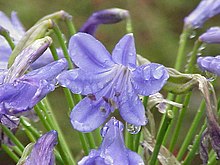Agapanthus
From Wikipedia, the free encyclopedia
| Agapanthus | |
|---|---|
 | |
| Agapanthus praecox | |
| Scientific classification | |
| Kingdom: | Plantae |
| Clade: | Tracheophytes |
| Clade: | Angiosperms |
| Clade: | Monocots |
| Order: | Asparagales |
| Family: | Amaryllidaceae |
| Subfamily: | Agapanthoideae |
| Genus: | Agapanthus L'Hér. |
| Type species | |
| Agapanthus africanus | |
| Synonyms[1] | |
| |
 Agapanthus flower and leaves
Agapanthus flower and leavesAgapanthus /ˌæɡəˈpænθəs/[2] is a genus of plants, the only one in the subfamily Agapanthoideae of the family Amaryllidaceae.[3] The family is in the monocot order Asparagales. The name is derived from Greek: ἀγάπη (agapē – "love"), ἄνθος (anthos – "flower").
Some species of Agapanthus are commonly known as lily of the Nile, or African lily in the UK. However, they are not lilies and all of the species are native to Southern Africa (South Africa, Lesotho, Eswatini, Mozambique), though some have become naturalized in scattered places around the world (Australia, Great Britain, Mexico, Ethiopia, Jamaica, etc.).[1][4]
Species boundaries are not clear in the genus, and in spite of having been intensively studied, the number of species recognized by different authorities varies from 6 to 10. The type species for the genus is Agapanthus africanus.[5] A great many hybrids, and cultivars, have been produced. They are cultivated throughout warm areas of the world. They can especially be spotted throughout Northern California.[6] Most of these were described in a book published in 2004.[7]
Contents
1
No comments:
Post a Comment